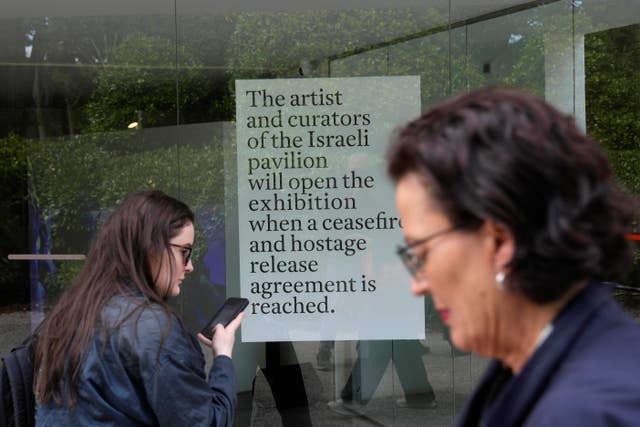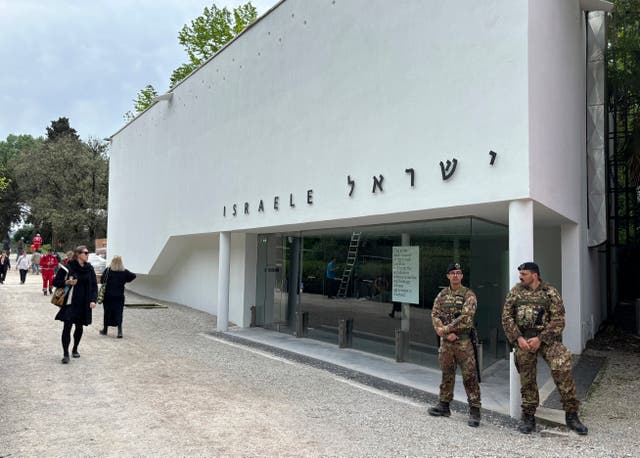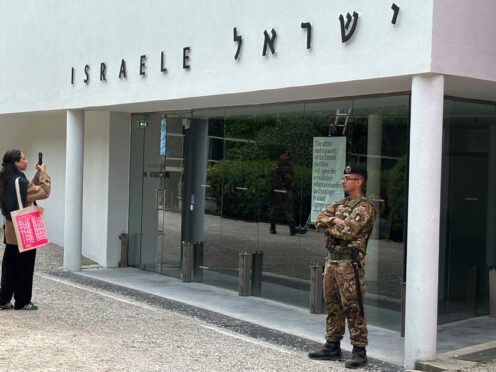The artist and curators representing Israel at this year’s Venice Biennale have announced they will not open the Israeli pavilion exhibit until there is a ceasefire in Gaza and an agreement to release hostages.
“The art can wait, but the women, children and people living through hell cannot,” the curators said in a statement together with the artist that expressed horror at both the plight of Palestinians in Gaza and relatives of hostages taken from Israel.
Their decision, praised as courageous by the festival’s main curator, was posted on a sign in the window of the Israeli national pavilion on the first day of media previews, just days before the Biennale contemporary art fair opens on Saturday.

Israel is among 88 national participants in the 60th Venice Biennale, which runs from April 20-November 24.
The exhibition in the Israeli national pavilion had been titled (M)otherland by artist Ruth Patir.
Even before the preview, thousands of artists, curators and critics had signed an open letter calling on the Biennale to exclude the Israeli national pavilion from this year’s show to protest against Israel’s war in Gaza.
Those opposed to Israel’s presence had also vowed to protest on-site.
Italy’s culture minister had firmly backed Israel’s participation, and the fair was opening amid unusually heightened security.
Written in English, the announcement on Tuesday of Israel’s delayed opening read: “The artist and curators of the Israeli pavilion will open the exhibition when a ceasefire and hostage release agreement is reached.”
Two Italian soldiers stood guard nearby.
In a statement, Patir said she and the curators wanted to show solidarity with the families of the hostages “and the large community in Israel who is calling for change”.
“As an artist and educator, I firmly object to cultural boycott, but I have a significant difficulty in presenting a project that speaks about the vulnerability of life in a time of unfathomed disregard for it,” Patir said in the statement.
Patir, who remained in Venice on Tuesday, declined further comment, as did the Biennale organisers.
Adriano Pedrosa, the Brazilian curator of the main show at the Biennale, praised the gesture.
“It’s a very courageous decision,” Pedrosa told The Associated Press.
“I think it’s a very wise decision as well” because it is “very difficult to present a work in this particular context”.
The national pavilions at Venice are independent of the main show, and each nation decides its own show, which may or may not play into the curator’s vision.
Palestinian artists are participating in collateral events in Venice and three Palestinian artists’ works are to appear in Pedrosa’s main show, titled Stranieri Ovunque – Foreigners Everywhere, which has a preponderance of artists from the global south.
Pedrosa, the artistic director of Brazil’s Sao Paulo Museum of Art, said one of the Palestinian artists, New York-based Khaled Jarrar, was not physically in Venice because he could not get a visa.

The curators of the Israeli pavilion, Mira Lapidot and Tamar Margalit, said they were delaying the opening of the exhibit because of the “horrific war that is raging in Gaza”, but that they hoped the conditions would change so the exhibit could open for public view.
“There is no end in sight, only the promise of more pain, loss, and devastation. The exhibition is up and the pavilion is waiting to be opened,” they said.
For now, a video work made by Patir can be seen through the pavilion window.
Geopolitics is no stranger to the Biennale.
The Italian festival discouraged, and then banned, South Africa’s participation during apartheid.
Russian artists withdrew their participation in 2022 to protest over the Kremlin’s invasion of Ukraine, and the Biennale said Russia did not request to participate in this year’s edition.
The war in Gaza erupted after Hamas and Islamic Jihad carried out a cross-border attack on October 7 that killed 1,200 people in Israel and kidnapped 250 others.
Israel’s retaliatory offensive in Gaza has so far killed more than 33,700 Palestinians, according to local health officials, causing widespread devastation.
The United Nations has warned of imminent famine in northern Gaza.
